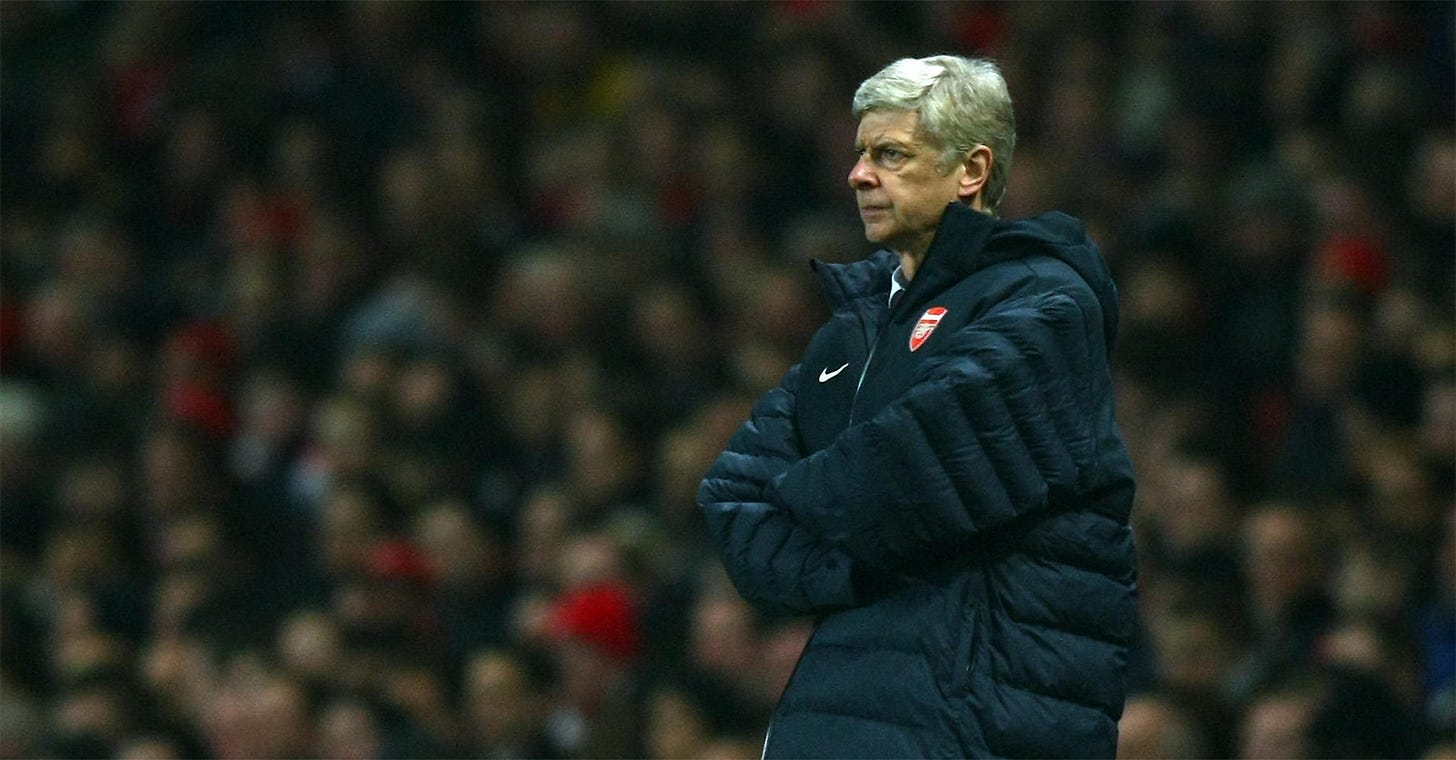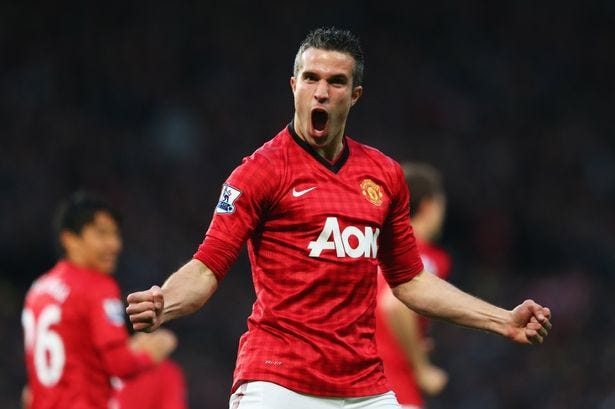The Fall of Arsene Wenger
Arsene Wenger has taken Arsenal to their greatest heights and has allowed them to fall to their lowest ebb and what was once unthinkable, that Le Professeur should ever be told his services are no longer required
Sixteen years, eleven trophies. An undefeated Invincible season, glorious cup doubles, perennial Champions League contenders and some of the most scintillating football to ever grace England and Europe. Arsenal’s longest serving and most decorated manager, Arsene Wenger and his studious, professorial approach to the world game has transformed the North London side from a club infamous for its sleep inducing long ball approach to a team that has become synonymous for elegant, quick footed players that dazzle their opponents and the crowd with sublime skill and artistry. Arsene Wenger is a giant of football who will be remembered as not only a legend of Highbury but of the game itself. And yet over the last four years, the North London temple that Wenger built, which was to be his monument to the gods of total football, has gradually been defiled to the point that the only sensible recourse is to remove the legend from his throne and rebuild the once mighty Gunners.
No longer is Arsenal seen as a heavyweight of English football. No longer is Arsenal the preferred destination of football’s best and brightest. No longer is Arsenal a genuine title contender. Instead, Arsenal has become the refuge for overpaid, underachieving players and the training ground for talented youngsters to hone their craft before moving on to bigger clubs that actually win trophies. The Gunners no longer strike fear into the hearts of their opponents, rather they are seen as soft targets ripe for the picking, as witnessed by their humbling at the hands of lowly Bradford and their dismantling from European giants, Bayern Munich. Arsene Wenger has taken Arsenal to their greatest heights and has allowed them to fall to their lowest ebb and what was once unthinkable, that Le Professeur should ever be told his services are no longer required is becoming more and more palatable as the Gunner faithful finally begin to lose patience after eight long years without silverware.
Debate over who is to blame for Arsenal’s steady decline has raged for years now but there can be little doubt that Wenger is one of the major causes. For all of his undeniable acumen when it comes to identifying, nurturing and maximising the talent of young footballers, Wenger’s own stubborn streak and unwillingness to adapt to the new environment of 21st century football has been his undoing. In a world where bored billionaire ego maniacs can buy a club with some of their loose change and quickly reshape their new toy in their own image by purchasing the world’s best players with their lazy millions, Wenger’s Arsenal has been left behind due to its unwillingness to spend money.
Wenger rightfully rails against the billions of dollars that have flooded the game and upset the natural order of European football. Wenger proudly trumpets that Arsenal has achieved Champions League qualification for fifteen consecutive years whilst spending a fraction of what most other clubs have shelled out. However it doesn’t change the fact that Wenger’s noble ideals have seen Arsenal fall behind as new cashed up clubs like Chelsea, Manchester City and Paris St Germain have shot to prominence and glory.
Wenger’s greatest strength, identifying young talent, has been rendered void in today’s football climate.
Yet although Wenger often cries poor and that Arsenal are burdened with paying off their new Emirates Stadium, the statistics don’t match the argument. Arsenal are the sixth richest club in world football and have the ninth highest wage bill in the sport. With an array of global sponsorship deals, a never ending stream of sold out home games in a 60,000 seat stadium packed with corporate boxes, it’s clear that Arsenal have money to spend. This unwillingness to spend money has been interpreted by fans, pundits and most importantly, players as a lack of ambition and has resulted in a traumatic talent drain that has robbed Arsenal of its blue chip players.
As Patrick Vieria, Theirry Henry, Ashley Cole, Cesc Fabregas, Emmanuel Adebayor, Samir Nasri, Kolo Toure, Alex Song, Gael Clichy and most recently Robin Van Persie have prematurely left the club, they’ve been replaced by cheaper, inferior talent such as Gervinho, Alexander Hleb, Andrei Arshavin, Tomas Rosicky and Sebastien Squillaci who are incapable of maintaining the high standards of yesteryear. Some will point out that of that list of departures, Patrick Vieria left at a time when his powers were in decline however it isn’t coincidence that Arsenal’s last trophy came in 2005 when Vieria’s poise and steely resolve commanded the centre of the pitch as well as the Gunners’ dressing room. Nevertheless, each departure has chipped away at Arsenal’s aura and slowly reduced them from heavyweights to a team comprised of journeymen and underachievers.
In a perverse sense, Arsenal’s decline can be attributed to Wenger’s success. Arsene Wenger’s arrival at Highbury in 1996 heralded a new era for English football. Not only did he bring with him an eye for talent that would propel Arsenal to the top of the Premier League and his breakthroughs in the field of sports science gave the Gunners a tactical advantage, but most of all it was Wenger’s vision of football and how it should be played that reshaped the English landscape. Wenger’s game plan of movement, short passing and fluidity sounded the death knell for England’s penchant for long ball punts and transformed the Premier League into the most popular competition in the world. All of these innovations immediately set Arsenal ahead of the pack but over the last decade these advantages have dissolved as opponents have adapted to and adopted Wenger’s schemes.
One man who would best understand Arsene Wenger’s predicament is his chief rival and the only man who would be considered of higher stature, Sir Alex Ferguson. Throughout his 26 years in the Old Trafford hot seat, Ferguson has had to deal with player retirements, failed player relationships, transfer sales and changing tactics and strategies, just like Wenger. However unlike Wenger, Sir Alex has demonstrated a remarkable ability to rebuild his squad without losing quality and adapt new strategies into his game plan that has allowed Manchester United to pick up trophy after trophy. A willingness to spend money also hasn’t hurt either. Ferguson’s chameleon nature has kept him at the top of the game for far longer than should be possible while Wenger’s glorious vision and stubborn nature has seen him and his team rise and fall spectacularly.
The danger of staying anywhere too long is that after all the good times, eventually things will start to turn sour. The golden rule of stand up comedians is to always leave the audience wanting more as opposed to staying for one joke too many and tainting the high spots. It seems wrong to criticise a man for demonstrating supreme loyalty to his employers but one cannot help but wonder what if Arsene Wenger had taken up one of those offers that came from Real Madrid during the 2000s. Wenger’s legacy at Highbury would remain undamaged and would still shine bright while perhaps Arsenal, with a fresh manager, would have been better equipped to deal with the changing landscape of modern football.
Right now Wenger and Arsenal are stuck in an unhappy marriage that neither side is willing to end for fear of what the unknown will bring. However a separation would be best for both parties. It would allow Wenger to recharge his energy and perhaps launch him towards another club in need of his vision and ideas, while Arsenal would have the opportunity to appoint a new manager tasked with reinvigorating and rebuilding a club that has clearly gone stale.
Wenger’s place as Arsenal’s greatest manager is beyond doubt but all good things eventually come to an end. There comes a time in every partnership when you must learn that if you truly love something then eventually you have to let it go.






